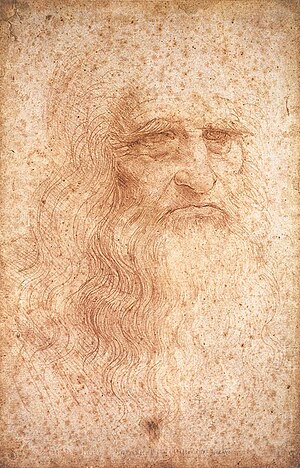Self-Portrait (Leonardo da Vinci)

|
| Self-portrait of Leonardo da Vinci |
|---|
| Leonardo da Vinci , around 1512 |
| Red chalk on cardboard |
| 33 × 22 cm |
| Biblioteca Reale, Turin |
The Portrait of a Man is a drawing dated around 1512 in the holdings of the Biblioteca Reale in Turin . It is commonly referred to as a self-portrait by the Italian Renaissance artist Leonardo da Vinci (1452–1519). However, whether the work is a self-portrait is highly controversial.
The portrait is a frequently reproduced drawing and is mainly used to depict the person of Leonardo da Vinci as an artist , Renaissance man and universal genius .
description
The portrait is done in red chalk on cardboard. It shows the head of an elderly man in quarter profile ; the face is turned slightly from the frontal view. The person depicted is characterized by their long hair and a long, billowing beard that falls over the shoulder to the chest. The length of the hair and beard is unusual for High Renaissance portraiture .
The person has a slightly curved nose and is marked by deep wrinkles on the forehead and bags under the eyes. It seems as if the man has lost his upper incisors so that the philtrum , the indentation between the nose and upper lip, has collapsed. The person's eyes are not directed towards the viewer, but look past him, somewhat veiled by the long eyebrows.
The work is drawn in fine lines. Shadows were set by hatching , which was apparently done with a left hand. Leonardo was pronounced left-handed .
The paper has brownish spots due to the accumulation of iron salts caused by moisture. In the Biblioteca Reale, the drawing is generally not open to the public because of its sensitivity and poor condition.
History and controversy
Whether the work is actually a self-portrait is a matter of controversy among critics. The identity of the person portrayed is doubtful and the authorship is not guaranteed.
The drawing only became known to the public in the 19th century. Most of the drawings from Leonardo da Vinci's estate were kept in his villa near Vaprio d'Adda by his pupil and heir Francesco Melzi (around 1491/92 - around 1570) after his death . His son Orazio Melzi inherited the documents in 1570. The sheets were sold and the valuable material was scattered.
In 1840, Duke Karl Albert of Savoy acquired the work from a collector. At this point in time, the drawing was already being referred to as the “self-portrait of Leonardo da Vinci”. The title is based on the obvious resemblance of the sitter to the figure of Plato , embodied by Leonardo da Vinci, on Raphael's (1483–1520) fresco “ The School of Athens ”. It came from the collection of the House of Savoy to the holdings of the Biblioteca Reale.
A frequent objection is that the drawing depicts a man of a considerably older age; the artist himself died in 1519 at the age of 67. On the other hand, it is claimed that contemporary witnesses reported that the artist had aged a lot in the last years of his life. It is believed that in the last few years of his life he suffered from the effects of a stroke , a right-sided hemiparesis .
Other theses say that it is less a question of a self-portrait, but more of a " self-caricature ". It is also believed that the person represents Leonardo's father, the lawyer Piero da Vinci (1427− around 1504).
The German art historian Hans Ost attributed the work in 1980 to the Italian painter and etcher Giuseppe Bossi (1777-1815).
More Leonardo illustrations
|
|
|
|---|---|
| A possible self-portrait by Leonardo da Vinci in “The Adoration of the Magi from the Orient”, around 1481. |
Other portraits made during Leonardo's lifetime are attributed to other artists, for example a profile portrait from the Royal Collection in Windsor Castle of his student Francesco Melzi.
There are probably other images of Leonardo that show him as a teenager or young man. This includes the "Statue of David" made before 1476 by the painter and sculptor Andrea del Verrocchio (1435 / 36–1488). Leonardo received his artistic training from around 1470 to 1477 as a student of Verrocchio in Florence. It is conceivable that Verrocchio took his young student as a model for David.
Leonardo da Vinci himself began to design the painting “ The Adoration of the Magi ” around 1481 . The picture was left unfinished. Some critics suspect that a figure in the lower right corner of the picture represents Leonardo. However, the representation does not have the character of an independent portrait.
If the drawing in the Biblioteca Reale is authentic, it remains Leonardo's only self-portrait.
- Possible contemporary portraits
literature
- Martin Kemp : Leonardo . C. H. Beck, Munich 2008, ISBN 978-3-406-56821-3
- Charles Nicholl : Leonardo da Vinci - The biography . S. Fischer, Frankfurt am Main 2006, ISBN 978-3-10-052405-8
Web links
Individual evidence
- ↑ a b c Nicholl, p. 30
- ↑ a b c d Nicholl, p. 617 ff
- ↑ Kemp, p. 62
- ↑ Peter Dittmar: Did Leonardo da Vinci draw this self-portrait? In: Welt Online, March 3, 2009 , accessed April 1, 2012
- ↑ a b Hans Ost: The Leonardo portrait in the Kgl. Turin library and other forgeries by Giuseppe Bossi . Gebrüder Mann Verlag, Berlin 1980, ISBN 3-7861-1299-1
- ↑ a b Nicholl, p. 568
- ↑ Nicholl, p. 600 ff
- ↑ Nicholl, p. 106
- ↑ Nicholl, p. 227





